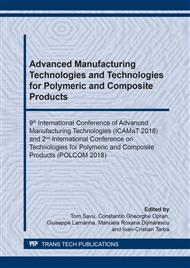[1]
F. Caputo, G. Lamanna, A. De Luca, V. Lopresto, Numerical Simulation of LVI Test onto Composite Plates, AIP Conference Proceedings 1599 (2014) 334-337.
DOI: 10.1063/1.4876846
Google Scholar
[2]
L. Grassia, M. Iannone, A. Califano, A. D'Amore, Self-learning health monitoring algorithm in composite structures, AIP Conference Proceedings 1932 (2018) 030011.
DOI: 10.1063/1.5024161
Google Scholar
[3]
A. De Luca, D. Perfetto, G. Petrone, A. De Fenza, F. Caputo, Guided-Waves in a Low Velocity Impacted Composite Winglet, Key Engineering Materials 774 (2018) 343-348.
DOI: 10.4028/www.scientific.net/kem.774.343
Google Scholar
[4]
G. Lamanna, C. Opran, D. Perfetto, Development of an established FE model for the simulation of LVI tests on GFRP plates, AIP Conference Proceedings 1981 (2018) 020136.
DOI: 10.1063/1.5045998
Google Scholar
[5]
D. Perfetto, A. Greco, F. Caputo, Experimental investigation of GFRP plates under LVI phenomena with different impact energy levels, AIP Conference Proceedings 1981 (2018) 020137.
DOI: 10.1063/1.5045999
Google Scholar
[6]
A. De Luca, Z. Sharif-Khodaei, M.H. Aliabadi, F. Caputo, Numerical Simulation of the Lamb Wave Propagation in Impacted CFRP Laminate, Procedia Engineering 167 (2016) 109-115.
DOI: 10.1016/j.proeng.2016.11.676
Google Scholar
[7]
F. Caputo, F. Di Gennaro, G. Lamanna, A. Lefons, A. Riccio, Numerical procedures for damage mechanisms analysis in CFRP composites, Key Engineering Materials 569-570 (2013) 111-118.
DOI: 10.4028/www.scientific.net/kem.569-570.111
Google Scholar
[8]
F. Caputo, G. Lamanna, A. De Luca, R. Borrelli, S. Franchitti, Global-local FE Simulation of a plate LVI test, SDHM Structural Durability and Health Monitoring 9 (3) (2013) 253-267.
DOI: 10.32604/sdhm.2013.009.253
Google Scholar
[9]
A. Riccio, A. Sellitto, S. Saputo, A. Russo, M. Zarrellli, V. Lopresto, Modelling the damage evolution in notched omega stiffened composite panels under compression, Composites Part B-Engineering 126 (2017) 60-71.
DOI: 10.1016/j.compositesb.2017.05.067
Google Scholar
[10]
A. Riccio, A. Russo, A. Sellitto, A. Raimondo, Composite Structures 168 (2017) 104-119.
Google Scholar
[11]
A. Riccio, M. Damiano, A. Raimondo, G. Di Felice, A. Sellitto, Development and application of a numerical procedure for the simulation of the Fibre Bridging, phenomenon in composite structures, Composite Structures 145 (2016) 203-216.
DOI: 10.1016/j.compstruct.2016.02.081
Google Scholar
[12]
H. Mertz, P. Prasad, G. Nusholtz, Head injury risk assessment for forehead impacts, SAE Technical Paper 960099 (1996).
DOI: 10.4271/960099
Google Scholar
[13]
J.S.H.M. Wismans, Injury biomechanics (1994).
Google Scholar
[14]
J.S. Ruan, C. Zhou, T.B. Khalil, A.I. King, Computer Techniques and Computational Methods in Biomechanics 1, Chapter 7 (2001).
Google Scholar
[15]
L. Xiaochuan, G. Jun, B. Chunyu, S. Xiasheng, M. Rangke, Drop test and crash simulation of a civil airplane fuselage section, Chinese Journal of Aeronautics 28 (2) (2015) 447-456.
DOI: 10.1109/mec.2013.6885545
Google Scholar
[16]
G. Lamanna, F. Caputo, A. Soprano, Numerical Investigation on the Structural behavior of a composite impact absorber, Key Engineering Materials 417-418 (2010) 685-688.
DOI: 10.4028/www.scientific.net/kem.417-418.685
Google Scholar
[17]
F. Caputo, A. De Luca, A. Greco, S. Maietta, A. Marro, A. Apicella, Investigation on the static and dynamic structural behaviors of a regional aircraft main landing gear by a new numerical methodology, Frattura ed Integrità Strutturale 12 (43) (2018) 191-204.
DOI: 10.3221/igf-esis.43.15
Google Scholar
[18]
S.K. Ekman, M. Debacker, Survivability of occupants in commercial passenger aircraft accidents, Safety Science 104 (2018) 91-98.
DOI: 10.1016/j.ssci.2017.12.039
Google Scholar
[19]
M. Waimer, D. Kohlgrüber, D. Hachenberg, H. Voggenreiter, Experimental study of CFRP components subjected to dynamic crash loads, Composite Structures 105 (2013) 288-299.
DOI: 10.1016/j.compstruct.2013.05.030
Google Scholar
[20]
M. Guida, F. Marulo, Partial modeling of aircraft fuselage during an emergency crash landing, Procedia Engineering 88 (2014) 26-33.
DOI: 10.1016/j.proeng.2014.11.122
Google Scholar
[21]
F. Marulo, M. Guida, F. Di Caprio, M. Ignarra, A. Lamboglia, B. Gambino, Fuselage crashworthiness lower lobe dynamic test, Procedia Engineering 167 (2016) 88-96.
DOI: 10.1016/j.proeng.2016.11.678
Google Scholar
[22]
K.E. Jackson, E.L. Fasanella, Design, Testing, and Simulation of Crashworthy Composite Airframe Structures at NASA Langley Research Center, Comprehensive Composite Materials II 8-8 (2018) 286-307.
DOI: 10.1016/b978-0-12-803581-8.10063-3
Google Scholar
[23]
M. Mahé, H. Ribet, F. Le Page, Composite fuselage crash FE modelling dedicated to enhance the design in correlation with full scale drop test, Mécanique & Industries 2 (1) (2001) 5-17.
DOI: 10.1016/s1296-2139(00)01081-2
Google Scholar
[24]
Federal Aviation Administration (FAA), 14 CFR 25.562 (2006).
Google Scholar


